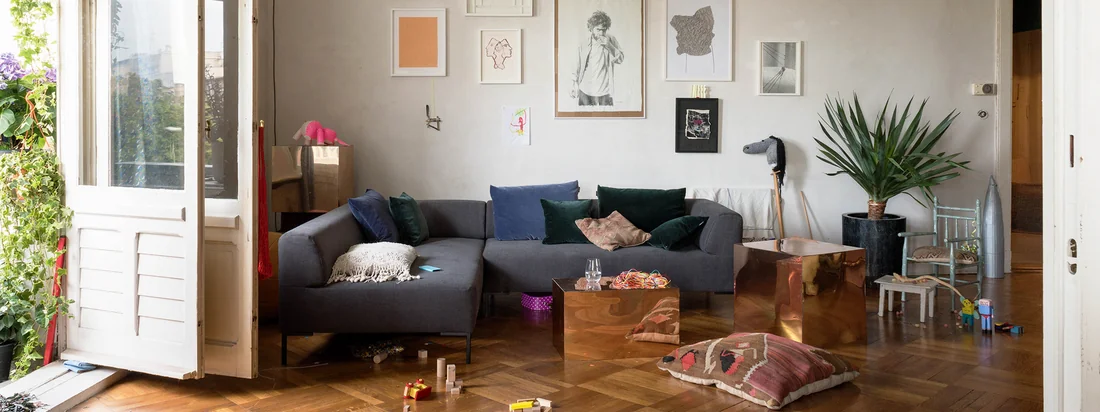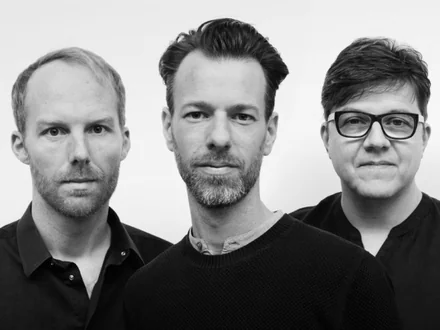The well-known German design author Bernd Polster writes in his book “Wohndesign Deustchland – Die Klassiker”: Neuschwanstein Castle and the Bauhaus are German myths that are virtually carved in stone, and yet they represent visions of domesticity that could hardly be more opposite. Between them lies a revolution – a political one of course, but also a cultural one. In the course of this turnabout, dusty romantic props that had been accumulating all through the 19th century were all at once swept aside. This left behind a shocking void and a grandiose free space for creativity. The innovation engine that was cranked up back then is still driving German design today. Whether we think of the cantilevered chair, the functional lamp, the tableware service or flexible sofa arrangements, at the heart of it all is nothing less than the intention to create a whole new system of objects for daily use.
Today many German manufacturers and designers are known all over the world. From A as Depot4Design, a company which is known for its synthetics furniture and products, to Z as Zwiesel, an old manufacture for premium crystal glass products – German companies are well organised when it comes to exporting design. Also, German designers, such as Konstantin Grcic or Stefan Diez are internationally renowned designers of furniture and products – not least due to their cooperation with international companies. Institutions funded by state and economy have also contributed to the predicate “Design – Made in Germany” as they annually award internationally renowned design prices, such as the Designpreis der BRD, the red dot award, the iF award or the Design Plus award.
The following historical overview helps you getting a rough picture of the tradition and history of home design in Germany. A more complete version can be found in the book “WOhndesign Deustchland – Die Klassiker” by Bernd Polster, which has already been mentioned.
Chronology:
1830: Furniture that imitates the styles of bygone eras is shown at exhibitions. Historicism takes root and with it the fruitless search for a “German style”.
1835: Pioneer Michael Thonet applies his bentwood technique to a chair in Boppard am Rhein and with it develops the first series furniture. Chair No. 14 from 1859 is the first piece of furniture to be produced over a million times and an early example of industrial design.
1876: The German Art and Industry Exposition in Munich makes the Neo- Renaissance popular, a massive style that is today considered “old German” and which epitomizes our image of German furniture. – At the World Exposition in Philadelphia, Germany shines with nationalist kitsch. With its show “Germania, Prussians, Kaiser, Crown Prince and Bismarck”, the economic upstart reveals its stylistic deficits.
1887: As a strategy against cheap imports, England introduces the label “Made in Germany”.
1892: Artists turn their backs on the established art market to found the “Munich Secession”. A few of the apostates, such as Peter Behrens, soon turn their attention to applied arts (further secessions follow in 1897 in Vienna and 1898 in Berlin).
1897: The International Art Exhibition in Dresden spells the breakthrough for Belgian Henry van de Velde and Jugendstil furniture. – At the VIIth International Art Exhibition in Munich’s Glass Palace, “modern minor arts”, although shown only in two rooms, cause a sensation. – Magazines like Deutsche Kunst und Dekoration, InnenDekoration and Dekorative Kunst propagate the new curvaceousness in design. – Biedermeier is rediscovered and now appraised positively.
1898: The Vereinigten Werkstätten für Kunst im Handwerk (United Workshops for Art in Craftsmanship) in Munich and the Dresdner Werkstätten für Handwerkskunst (Dresden Workshops for Handicraft Art) are founded based on the English model. The two successful enterprises merge a good decade later to become the Deutsche Werkstätten (German Workshops). They mark the beginning of a workshop movement that aims at a “room art” inspired by Jugendstil. A number of creative talents come together in Munich, including Peter Behrens, August Endell, Hermann Obrist, Josef Maria Olbrich, Bruno Paul and Richard Riemerschmid. In Dresden, artisan and idealist Karl Schmidt sets out to turn his company into a real-life utopia. He relocates to a suburb called Hellerau and erects his enterprise in a garden town designed by architect Riemerschmid. (other foundings: in 1899 the Werkstätten für angewandte Kunst [Workshops for Applied Art] by Henry van de Velde in Berlin, in 1900 the Saalecker Werkstätten [Saaleck Workshops] by architect and “homeland preservation” pioneer Paul Schultze- Naumburg, in 1902 the Königliche Lehr- und Versuchswerkstätten [Royal Teaching and Experimentation Workshops] in Stuttgart, in 1903 the Wiener Werkstätte.
1900: At the otherwise mostly conservative World Exposition in Paris, the German reformists walk off with several gold medals. The turbulent Jugendstil, which is already beginning to ebb, has put an end to historicism. But the transformation of taste is not yet complete. The motto is now reason and Sachlichkeit – objectivity. – The magazine Kunstwart publishes Ten Commandments for Furnishing the Home. Number one: “Furnish your home practically!”
1903: In the course of a design reform from above, Peter Behrens becomes director of the Kunstgewerbeschule (School of Arts & Crafts) in Düsseldorf. – The thermos and sparkplug are just two of his many inventions.
1905: Vehement debates take place in Germany on what a “beautiful home” should look like. – Richard Riemerschmid, by now a prominent figure, works for the Meissen porcelain factory, the Villeroy & Boch earthenware industry in the Westerwald and for WMF. – Kitchen maker Poggenpohl produces furniture in simple Werkstätten style. – Ludwig Mies van der Rohe moves to Berlin. – In Dresden, the artists’ group Die Brücke begins to paint in a more “straightforward and genuine” manner.
1906: At the III. Deutsche Kunstgewerbe-Ausstellung (Third German Applied Arts Exhibition) in Dresden, Riemerschmid’s machine-made furniture is displayed, an extensive program designed for the first time for factory production.
1907: The Deutscher Werkbund is the first German design association to bring artists and manufacturers together – a model that is then adopted in other countries such as England and Sweden. This educational initiative is driven forward by means of publications and exhibitions, which take place in 1912 in the USA, 1914 in Cologne and 1927 in Stuttgart. Since the aim is also to promote exports, chauvinism is rampant, as demonstrated by fighting words such as “Deutsche Wertarbeit” – high-quality German craftsmanship. – Peter Behrens, a co-founder of the Werkbund, becomes artistic adviser to AEG in Berlin. For the electric company, whose state-of-the-art products have up to that time been cloaked in historicizing styles, the pioneer of industrial design develops a simply designed product range that lend it a more streamlined corporate identity. This comprehensive program is a world premiere.
1914: The Werkbund Exhibition in Cologne, an imposing showcase of the new wave in design, has to close early due to the outbreak of world war.
1918: The First World War ends with capitulation and revolution.
1919: The first German republic and the state-run Bauhaus are established in Weimar. Founding director Walter Gropius sets up his academy in the Werkstätten tradition.
1923: The model home “Am Horn”, with which the Bauhaus presents its work for the first time, is an experiment in “Neues Wohnen”, New Design for Living. The furnishings are based on concepts in which mechanics and modularity play an important role, such as in the innovative children’s room by Alma Buscher. But the truly sensational aspect of the show is the shocking simplicity of the interiors. – In Hamburg Karl Schneider designs Villa Michaelsen, an early work of the “Neues Bauen” (New Building) and “Offenes Wohnen” (Open Living) movements. – Currency depreciation reaches a climax.
1924: The economy begins to recover. Berlin becomes the world’s cultural capital. – Form ohne Ornament (Form Without Ornament) is the title of a touring exhibition of the German Werkbund, which provides the Modernists with a motto. – Marianne Brandt revolutionizes the dining table with her ornament-free Tee-Extrakt-Kännchen (Tea Extract Pot). – Now ennobled as the “Bauhaus Lamp”, the WA 24, a joint work by Carl J. Jucker and Wilhelm Wagenfeld, is one of the first products to become a type, but fails to catch on immediately.
1926: The Bauhaus moves to Dessau into a new building that approaches quite closely the ideal of a functionalist total work of art. The event is lent drama by, for example, the use of the new tubular steel furniture, tangible symbols of the anti-cosiness aesthetic. The school encompasses seven master studios in which a cool ambience is displayed for the benefit of visiting journalists. Favourite words bandied about by the domestic rebels are “air” and “light”. These qualities are achieved through large windows and the monochrome white of the walls, which make the rooms seem all the emptier. – The magazines bauhaus and Das Neue Frankfurt become mouthpieces and discussion forums for the movement. – In Weimar Erich Dieckmann continues to design modern furnishings at the ex-Bauhaus, now dubbed the Bauhochschule (University of Architecture). – Mart Stam from the Netherlands, later a guest lecturer at the Bauhaus, invents the Freischwinger, or cantilevered chair, a furniture genre that will become a major hit the following year with Mies van der Rohe’s MR 10 easychair. – Margarete Schütte Lihotzky rationalizes cooking in her Frankfurt Kitchen. It becomes the prototype for all compact linear kitchens. – Functionalism, writes Hermann Muthesius in the second edition of his book Die Schöne Wohnung (The Dwelling Beautiful) is, as Jugendstil before it, merely an “eccentric” intermezzo.
1927: The model housing development in Stuttgart-Weissenhof attracts an array of young architects who represent “Neues Wohnen”, the new style of domesticity, including Josef Frank, Walter Gropius, Le Corbusier, Ludwig Mies van der Rohe, Hans Scharoun and Mart Stam. A radical break with all that has gone before, their domestic concepts seem more uniform than they actually are. Although, or perhaps precisely because, the project is just as controversial as the Bauhaus, it gives the modern movement a decided push.
1929: The German pavilion at the World Exposition in Barcelona, built by Ludwig Mies van der Rohe and furnished with his own designs, declares Neue Sachlichkeit as the official style of the republic. – In Frankfurt the exhibition The Chair shows modern seating from various countries. The first Cologne Furniture Fair is held in the new trade fair building. – The stock market crash in New York plunges the world into an economic crisis.
1932: Six million Germans are out of work. The economic and political situation comes to a head. – At the Berlin summer show Sonne, Luft und Haus für alle (Sun, Air and House for Everyone) 24 architects present entries in the competition Das wachsende Haus (The Growing House), small-format model homes that can be expanded. Represented are Erich Mendelsohn, Hans Scharoun and Egon Eiermann. – The exhibition Architecture: International Exhibition at New York’s Museum of Modern Art introduces German functionalism on US shores.
1935: Wilhelm Wagenfeld is the first artist to join corporate management, at the Lausitz Glassworks.
1939: In Deutsche Warenkunde (The Book of German Goods), a comprehensive almanac of exemplary objects of daily use published by the Ministry of Propaganda, products by émigré artists are also recommended, such as the Oranier Stove by Walter Gropius. The Second World War begins.
1945: World War II is over. In Berlin alone, over half a million homes have been destroyed.
1949: Lively exhibition activities reflect the contemporary dilemma: Wie Wohnen? (How to Furnish the Home?) is one of the most frequently asked questions of the day, finding its answer in an exhibition in Stuttgart and Karlsruhe. The solution lies in lightweight, often folding multifunctional furniture pieces. – At the Cologne Furniture Fair, which now resumes for the first time since the war, heavy-set “Stilmöbel”, old-fashioned pieces in historical styles, still dominate. The Deutscher Werkbund responds with its own counter-showcase; furniture prototypes are put on display under the old familiar title Neues Wohnen. – Finally, Max Bill of Switzerland sets down the first commandment for the next design reform in his exhibition Die Gute Form, which is at heart about domestic lifestyle. The second modern period has begun. – The swivel chair S 41 is one of the first furniture pieces manufactured by Wilde + Spieth, on the initiative of architect Egon Eiermann. His designs make the company one of the main suppliers of post-war Modernism.
1950: Young Philip Rosenthal is named head of advertising in the family enterprise and proceeds to mould it into the epitome of “good form” while inventing the idea of “designer as product author”. One of the firm’s
employees is the young artist Hans Theo Baumann, who made a spectacular debut with a plexiglass chair for Vitra, at the time still called Fehlbaum.
1951: A new generation sets the course for the future. Following the death of company founder Max Braun, his sons Erwin and Artur take over the helm of the Frankfurt phonograph firm, albeit not entirely voluntarily.
The changing of the guard proceeds in similar fashion at Rosenthal, Bofinger and Wilkhahn. Young, forward-looking entrepreneurs, who also include Heinz Röntgen, founder of Nya Nordiska, are disillusioned by the experience of war and set off on a quest for something different. Design, jazz and modern art are just the thing.
1952: Heinrich Löffelhardt becomes artistic director of Arzberg. 13 services bring “good form”, now also featuring the fashionable organic flow of line, to West German tables. – Archrival Rosenthal engages Wilhelm Wagenfeld, who simultaneously delivers designs to WMF and various lamp manufacturers. The amazingly productive old master, together with Hans Gugelot and Herbert Hirche, counts among the great mentors of the second new beginning in design. – In yet another completely revised edition of Die Schöne Wohnung, American and Scandinavian interiors are included for the first time.
1953: Instruction commences at the Hochschule für Gestaltung Ulm (Ulm Academy of Design), which views itself as successor to the Bauhaus. It likewise has a strong international focus and is just as magnetic an attraction for a young avant-garde. The students draw using the new Rapidograph ink pen from Rotring and sit on the Ulmer Hocker (Ulm Stool, 1955) in which a few of the academy’s most fundamental concepts are incorporated. It is simple as can be and astoundingly versatile. Hans Gugelot will later develop a furniture system for children based on this stool. – The Rat für Formgebung (German Design Council) is founded in Frankfurt and the Industrieforum (Industry Forum) in Hanover, two custodians of exemplary design. Both adopt an Italian invention: the design award. – The Museum of Modern Art in New York shows Thonet furniture, the first solo exhibition for an industrial enterprise.
1959: 120,000 copies of a completely revised version of Die Schöne Wohnung are sold by 1963 in four editions. Featured are numerous wall unit and shelf systems, but also an amazing variety of children’s rooms. – Students at the Ulm Academy put the analytical curriculum into practice in their dissertations. While Hans “Nick” Roericht develops the first functional dishware, stackable of course, Herbert Lindinger intellectually dissects the radio. His “building block concept” ultimately engenders Braun’s studio 2, the archetypical stereo system. – Peter Raacke’s sleek, straight-lined silverware mono-a is tantamount to a manifesto against the contemporary wave of culinary overindulgence.
1960: The Rosenthal Studio House in Nuremberg is a test run for the world’s first designer chain store. – In Hamburg the magazine Schöner Wohnen comes out, the first journal devoted exclusively to the domestic environment, whose name, roughly translatable as “Better Homes”, becomes part of the vernacular. Market researchers soon count over two million readers. One of the most popular columns is Peter Maly’s Skizzenbuch (Sketchbook), in which the young interior designer solves readers’ furnishing dilemmas. – The Bauhaus Archive is established on the Mathildenhöhe in Darmstadt.
1961: Dieter Rams is named head of design at Braun. The company, along with the department under his charge and he himself will become legendary. Rams belongs to the generation of war children whose formative years took place during the second period of Modernism and who has left his mark on the image of German design up until the present day. This cohort also includes such prominent personalities as Klaus Franck, Peter Maly, Ulf Moritz, Peter Raacke, Hans “Nick” Roericht and mavericks like Luigi Colani. – The Berlin Wall is also something new to the world.
1968: The last edition of Die Schöne Wohnung is bigger and more colourful than ever before, with 250 pages and over 600 illustrations. – An exhibition in Cologne shows Pop Art from the USA for the first time in Germany, a culture shock that forms the lively focus of documenta 4. Pop Art and pop music join forces. New styles now issue from the “underground”. – Plastic furniture changes people’s visual and sitting habits. There are sculptural pieces like Peter Ghyczy’s Gartenei (Garden Egg) or the slick TV-relax by Luigi Colani, as well as ergonomically optimized sitting machines such as the Floris chairs designed by Günter Beltzig and SM 400 by Gerd Lange. – Inflated visions are coupled with strict pragmatism. While Rolf Heide stacks sleeping surfaces on top of each other like industrial pallets in his Stapelliege (Stacked Lounger), Habit introduces the first stackable sofa: the Wohnlandschaft (Lounge Landscape). – Satellite housing developments start to spring up on green fields everywhere. Passing lanes are added to the motorways and pedestrian zones to city centres. Everything seems to fit into the neat grid projected by Ulm. – At the exhibition 50 Years of Bauhaus in Stuttgart, Germany and the rest of the world discover a long-buried past. – The Academy of Design in Ulm closes.
1970: At the Cologne Furniture Fair, Poggenpohl makes a splash with a spherical kitchen by Luigi Colani: the UFO version of the Frankfurt Kitchen. Going even this kitchen one better is the total interior dubbed Visiona, a psychedelic environment created by Basel-based Danish designer Verner Panton for chemical giant Bayer in the belly of a steamship on the Rhine. – Peter Maly goes out on his own and is taken on board by Leo Lübke as freelance art director at Interlübke, becoming one of the first Germans in the furniture industry to attain international standing. – Maly is succeeded at Schöner Wohnen by Rolf Heide, who from this post quietly influences West German home design for over two decades through his carefully staged domestic settings.
1974: Swedish furniture maker Ikea opens its first store near Munich, soon followed by many more. The company, whose early expansion largely takes place in Germany, is in the right place at the right time with its inexpensive furniture range. It becomes the supplier of choice for young, unconventional shoppers, alongside Schöner Wohnen the most important arbiter of taste when it comes to home furnishings.
1981:All is well apparently in the world of the new German objectivity. The wall clock ABW 41 by Dietrich Lubs and the Mono Classic teapot by Tassilo von Grolmann fuse formal sophistication with technical elegance.
1984: A whole series of quite disparate firms, including Thonet, Tecta, Tecnolumen and Vitra as well as later ClassiCon, Richard Lampert and sdr+, develop a historically reflexive relationship to their products. Important milestones in German design for living find their way back into their catalogues. An exception is formed by the company Anthologie Quartett, which still today devotes its energies to reviving the bold spirit of the 1980s. – Those who wish to can decorate their homes with the brainchildren of star designers. Brands such as Alfi, FSB and WMF rediscover the designer-branded product once introduced by Rosenthal, working sometimes on individual products and sometimes on an ongoing basis with the industry greats whose names promise quality design, an attractive image and healthy sales. – Let there be light: Following in the footsteps of Erco, Ingo Maurer, Anta, Mawa and Serien, Tobias Grau establishes yet another upscale brand for German lighting design.
1991: Konstantin Grcic opens a studio in his hometown of Munich and becomes Germany’s premier designer. He launches intense collaboration with the company ClassiCon founded one year earlier.
1996: Starting things off are brands such as elmarflötotto, Nils Holger Moormann, Performa, Sanktjohanser and Zeitraum. Other interesting projects soon join in, including Jonas & Jonas, Kaether & Weise, Raumwerk and Leise.
Source: www.formguide.de

 Authentics
Authentics
 frauMaier
frauMaier
 Hey Sign
Hey Sign
 Jenaer Glas
Jenaer Glas
 Konstantin Slawinski
Konstantin Slawinski
 Koziol
Koziol
 Radius Design
Radius Design
 Roomsafari
Roomsafari
 Rosenthal
Rosenthal
 Schönbuch
Schönbuch
 serien.lighting
serien.lighting
 Sirch
Sirch
 Tecnolumen
Tecnolumen
 Tojo
Tojo
 Vitra
Vitra
 Wilkhahn
Wilkhahn
 Auerberg
Auerberg
 freistil
freistil
 Müller Small Living
Müller Small Living
 Büro für Form
Büro für Form
 Christoph Böninger
Christoph Böninger
 Eckart Muthesius
Eckart Muthesius
 Felix Stark
Felix Stark
 Hertel & Klarhoefer
Hertel & Klarhoefer
 Konstantin Grcic
Konstantin Grcic
 Ludwig Mies van der Rohe
Ludwig Mies van der Rohe
 Marianne Brandt
Marianne Brandt
 Markus Jehs & Jürgen Laub
Markus Jehs & Jürgen Laub
 Richard Sapper
Richard Sapper
 Rolf Heide
Rolf Heide
 RSW Design
RSW Design
 Sebastian Herkner
Sebastian Herkner
 Stefan Diez
Stefan Diez
 Tobias Grau
Tobias Grau
 Walter Gropius
Walter Gropius
 Wilhelm Wagenfeld
Wilhelm Wagenfeld